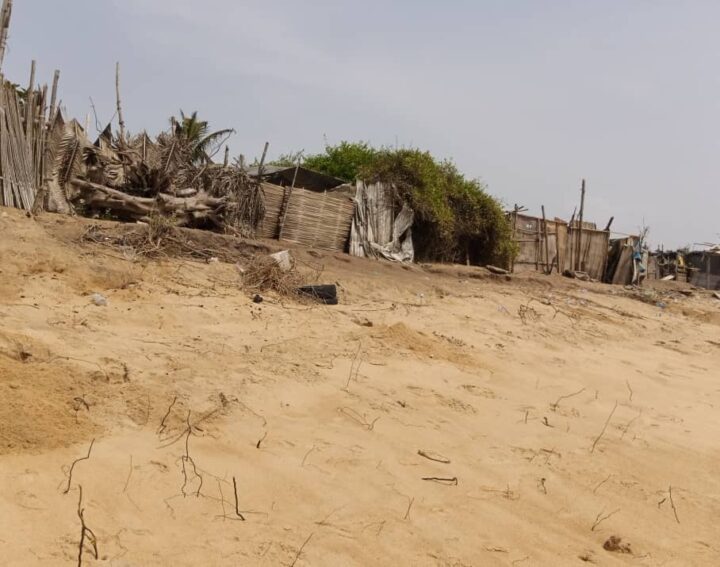Send to a friend
The details you provide on this page will not be used to send unsolicited email, and will not be sold to a 3rd party. See privacy policy.
In brief: Togo’s coastline is disappearing at a rate of between 1.8 and 5 metres every year. Large-scale infrastructure development has caused sediment erosion. In 2021, a SciDev.Net article drew attention to the plight of Togo’s displaced coastal communities. Media coverage of the issue, including that of SciDev.Net, drew the government’s attention to the urgency of the problem, helping to influence the subsequent action taken to protect coastal communities.
Why it matters: Coastal erosion is forcing people to leave their homes. Entire communities must be relocated, affecting every aspect of life from family to education and work.
The big picture: Coastal erosion not only affects coastal regions; it causes population displacement and migration, placing a burden on the country as a whole.
By the numbers: According to the authorities, around 2.5 million people live along the country’s coast. This equates to around 30 per cent of Togo’s 8.85 million population.
Background
In Togo, West Africa, coastal erosion has become a serious problem. According to a study carried out in 2015 by the West African Coastal Observation Mission, between 1.8 and 5 metres of coastline loss are recorded per year. Villages like Kossi Agbavi risk being wiped off the map if no action is taken.
Disruptive human activity, such as coastal infrastructure development, is said to be causing the long-term erosion of critical sediment. Since the construction of the Akosombo hydroelectric dam in neighbouring Ghana and Togo’s Autonomous Port of Lomé in the 1960s, more than 500 linear metres of land have been swallowed up by the sea. This includes many fishing villages and roads.
Agoro Sebabe, director of environmental assessments and integration at the National Agency for Environmental Management in Togo, explained how the Akosombo dam has decreased the transit of sedimentary deposits by 35 per cent, affecting the coastline from Ghana to Nigeria.
Residents have been forced to abandon their homes. Amétépé Gninivi Amédjé is a member of a Togolese village development committee. He said that people “are forced by the sea to abandon their homes to find rentals” and are losing “income-generating activities”. The rising waters have also affected a cemetery, forcing families to exhume bodies and bury them further inland.
What action did SciDev.Net take?
SciDev.Net first heard about the erosion crisis facing Togo’s coastal communities in October 2021. Understanding the potential cost of the emergency to inhabitants, in December 2021, SciDev.Net editor and regional coordinator for Sub-Saharan Africa Julien Chongwang commissioned a story from journalist Charles Djade.
Djade contacted experts, covering the story from an environmental and human interest angle, revealing the threat facing vulnerable communities along Togo’s coast and apparent causes of the erosion. Djade wrote the article, published on in January 2022, entitled, Togo: The race against time for coastal villages threatened by erosion.
SciDev.Net’s aim for the article was to raise awareness among Togo’s policymakers of the seriousness of coastal erosion, including the potential displacement of coastal communities and the subsequent impact on lives and livelihoods. The hope was that Togo’s government would understand the seriousness of the issue and take prompt action to address it.
This story was promoted on social media, especially on Facebook and Instagram, targeting audiences from Togo and neighbouring countries. So far, the article has received almost 2,800 direct views on SciDev.Net. We believe syndication will have extended the reach of the article even further. It is worth noting that syndication generally counts for more than 90 per cent of the total reach of SciDev.Net’s stories.
What was the impact of SciDev.Net’s action?
In June 2022, the Togolese government called for populations living along the coastline affected by erosion to evacuate the area, including residents of Kossi Agbavi, the village covered in the SciDev.Net news article. This would enable them to conduct defensive works and protect villages from coastal erosion.
In November 2022, after the population had moved out of the area, work began. With sea defences now under construction, Togo’s coastal villages are starting to benefit from better protection against the advancing waters.
The article led Yaou Lerry, director of environment at the Ministry for the Environment and Forest Resources in Togo, to name SciDev.Net as one of the news sources that prompted the government to evacuate areas affected by erosion and start coastal defence works.
She told the news outlet that press articles, “including that of SciDev.Net”, drew the government’s attention to the urgency of work to be carried out to halt the threat of coastal erosion.
This story demonstrates how a SciDev.Net article has helped influence a government to take a rapid action to address the critical issue of coastal erosion in this West African country. Ultimately, the work will benefit coastal villages and their inhabitants. According to the authorities, around 2.5 million people live along the country’s 50 km coast.


